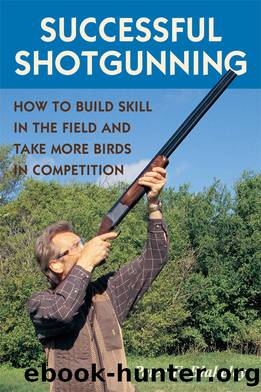Successful Shotgunning: How to Build Skill in the Field and Take More Birds in Competition by Peter F. Blakeley

Author:Peter F. Blakeley [Blakeley, Peter F.]
Language: eng
Format: epub
Tags: Sports & Recreation, Shooting
ISBN: 9780811743709
Google: vMO3DAAAQBAJ
Publisher: Stackpole Books
Published: 2003-08-01T20:29:24+00:00
In nature, geese fly in V formation, the strongest birds in the skein taking the lead while the younger and weaker birds fly behind with less air resistance to fight. This is known as slipstreaming or drafting. Exactly the same thing happens with the pellets of a shot column.
We have ten skeet fields at the club, and directly in front of these, we have a large lake. On calm days, when there is minimal wind and the surface is like a mirror, this lake has a practical use, and I like to use it to demonstrate to my students the effect of shot-string. I must stress that there is absolutely no scientific relevance here; it is merely a visual demonstration. As soon as a cloud of pellets leaves the muzzle of a shotgun, the shot begins to spread both laterally and longitudinally and develops into a rough sausage-shaped cloud, which is usually more dense at the front than at the back. The greater the distance from the muzzle, the greater the length of the shot-string. The effect of this âstringingâ can clearly be seen if a shot is fired into a smooth expanse of water, and from this demonstration, it is obvious that the charge of shot is three-dimensional.
Taking into account that at twenty yards a pattern from a cylinder barrel will be about thirty inches wide, and that obviously (depending on the angle to the surface of the water) there will be some difference between the arrival of the first and last pellets to hit the surface, there is a visually progressive differenceâthe pellets seem to ârun outâ along the surface. Wayward pellets and âflyersâ can clearly be seen as the pattern hits the surface of the water. It is rumored that Lieutenant Colonel Sir Peter Hawker, âthe father of game shooting,â often used the fast-flowing river test (which would obviously give a better visual demonstration than my expanse of still water), using a river that ran past his ancestral home, for similar demonstrations almost two hundred years ago. It was mentioned in his book, Instructions to Young Sportsmen in All That Relates to Guns and Shooting, written in 1814. However, apart from this visual demonstration, there is also an audible one. When shooting from a distance at a steel pattern plate with different loads, there is an obvious audible difference between the impact of the first pellets arriving at their target and that of the last pellets. So what causes this, and how can it affect our performance? Perhaps more importantly, is it beneficial to our shooting in any way and in what respect?
Many shotgunners genuinely believe that there is a huge advantage to a long shot-string, and I have been involved more than once in (sometimes heated) discussions concerning the advantages and disadvantages of degrees of choke and the resultant long shot-strings. We all know, for example, that a tight choke gives the advantage of a longer shot-string, doesnât it?
Afraid not. What barrel constriction will give is better pattern density, not a longer shot-string.
Download
This site does not store any files on its server. We only index and link to content provided by other sites. Please contact the content providers to delete copyright contents if any and email us, we'll remove relevant links or contents immediately.
Backpacker the Complete Guide to Backpacking by Backpacker Magazine(2193)
Capital in the Twenty-First Century by Thomas Piketty(1944)
The Isle of Mull by Terry Marsh(1891)
Predation ID Manual by Kurt Alt(1653)
The Collected Non-Fiction by George Orwell(1570)
Small-Bore Rifles by C. Rodney James(1502)
All Fishermen Are Liars by John Gierach(1443)
Backcountry Bear Basics by Dave Smith(1431)
Creative Confidence by Tom Kelley(1412)
The Art of Throwing by Amante P. Marinas Sr(1353)
50 Famous Firearms You've Got to Own by Rick Hacker(1338)
Archery: The Art of Repetition by Simon Needham(1301)
Blood Mountain by J.T. Warren(1301)
Long Distance Walking in Britain by Damian Hall(1278)
Backpacker Long Trails by Backpacker Magazine(1245)
The Scouting Guide to Survival by The Boy Scouts of America(1245)
The Fair Chase by Philip Dray(1224)
The Real Wolf by Ted B. Lyon & Will N. Graves(1209)
The Ultimate Guide to Home Butchering by Monte Burch(1200)
